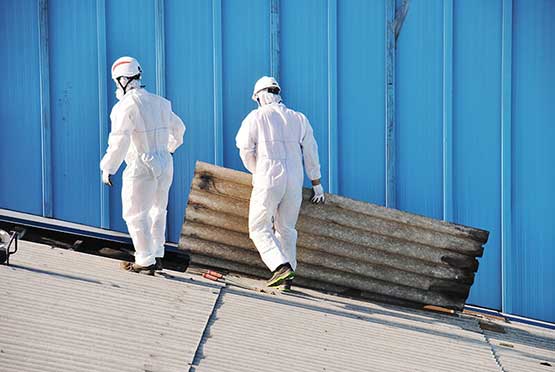
Removing Hazardous Waste
The combining of various types of dangerous waste, such as asbestos with non hazardous material is illegal.
The process of discarding hazardous waste alongside non-hazardous material at the same landfill site was banned in July, 2004. The Waste Acceptance Criteria (WAC) came into effect on 16 July 2005, which requires waste producers to guarantee their waste is lawful.

Did You Know?
A large amount of waste asbestos in London is corrugated roofing. According to The Land Registry, more than half (55%) of all industrial & commercial properties in the UK contain a white asbestos cement roof with fibre content between 10-15%

London Asbestos Removal
Dedicated Asbestos Experts
With over 25 years knowledge, we securely and safely remove all kinds of toxic materials for customers in London:
- Corrugated Garage Roofs
- Cement Roofing Shingles
- Guttering, Fascias & Soffits
- Millboard
- Rollboard Insulation
- Suspended Ceiling Tiles
- Floor Tiles
- Artex Textured Ceilings & Walls
- Acoustic & Decorative Ceiling Plasters
- Cement Pipes
- Heating & Ventilation Duct Insulation

Waste Consignment Note
We supply a ‘Waste Consignment Note’ issued on conclusion of work, plus documented copies are kept on file for three years in full conformity with Control of Asbestos Regulations 2012.
Under the Hazardous Waste Regulations 2005, waste consignment notes must be finalised either by the producer or the carrier with detailed information relating to key data, including:
- Quantity in Kilograms
- Chemical & Biological Components of Waste with Concentrations
- Physical Form
- Hazard Code(s)
- Container Type, Number & Size
- Proper Shipping Name
- Any Special Handling Requirements

What is Asbestos?
Predominantly used as a building component during the last century, asbestos is a fibrous mineral which is now understood to be extremely perilous to health.
Due to its common strength, as well as heat resistant characteristics, it understandably made for a suitable building material if it were not so bad for one’s health.
Composed of several minerals, asbestos belongs to the serpentine and amphibole categories of rock minerals.
Whilst different varieties of asbestos have varying degrees of danger, all asbestos is considered dangerous to health.
Anyone in contact with asbestos fibres is at serious risk of developing countless forms of cancer.

Why Is Asbestos Hazardous?
Asbestos becomes toxic when the fibres are damaged or disturbed, and are unleashed into the atmosphere.
If those fibres are inhaled, it can lead to a number of diseases, of which most are futile to treat and can become fatal.
These include:
- lung cancer
- ovarian cancer
- malignant mesothelioma
- laryngeal cancer
- asbestosis
- pleural thickening
Many top health agencies classify every type of asbestos as being carcinogenic.
Some of these investigations attempted to classify toxicity levels in asbestos, and concluded that Chrysolite, the serpentine asbestos category, is by far the worst in terms of danger to health.

Types of Asbestos
There are six kinds of asbestos, which come under either the amphibole or serpentine mineral groups, which are:
- Chrysotile (White Asbestos)
- Amosite (Brown Asbestos)
- Anthophyllite
- Crocidolite (Blue Asbestos)
- Actinolite
- Tremolite
Chrysolite is the only kind to come under the serpentine group, which incidentally is the most lethal.
Its form is typically formed of curly fibres and sheet crystals.
The other five come under the Amphibole group which have different fibres, often described as needle-shaped.
Although not as dangerous as serpentine-based asbestos, they are still considered as being highly dangerous.
Asbestos Removal All Across Greater London
Our Fleet Also Covers All Home Counties
Contact us for all your asbestos removal needs, wherever you're based in Kent, Essex, Surrey or East & West Sussex.
Do you need an asbestos survey? Let us help!
We have the capability to provide a high quality and efficient service, to locate and identify any suspect hazardous materials. Our service is fast and efficient, backed up by extremely competitive rates. So speak to KD Asbestos first!